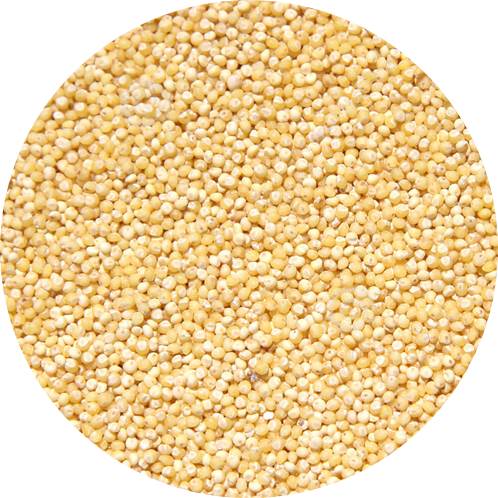MILLET, 25kg, PP bag
Valid Article
MILLET
Definition
Very high calorie and nutritional cereal, whose protein content is very close to that of wheat (about 11% of the weight).
Millet is rich in calcium, iron and B vitamins, particularly niacin, vitamin B6 and folacin.
Millet doesn't contain gluten and its flour is not suitable for making bread.
Specifications
Millet grains can be whole (obtained after threshing, with no mechanical treatment) or decorticated (outer part removed using mechanical treatment), and dried if necessary.
Technical specifications
| Quality factors | |
| Moisture content | < 14% |
Foreign matter
| < 2% < 0.5% |
| Dirt | none |
| Mineral particles (sand, etc.) | < 1% |
| Damaged grains | < 5% |
| Living insects | none |
| Dead insects | < 15/kg |
| Protein content (Nx5,7) | > 8% |
| Microbiology and contaminants | |
| Salmonella | negative in 25g |
| Total aflatoxins | 4 ppb |
Millet should be from the most recent harvest, and its origin should be clearly indicated (supported by original certificate of origin).
It should be "sound and market quality" and "fit for human consumption".
It should be free of abnormal smell and/or taste.
A fumigation certificate dated within last 15 days must be presented upon receipt.
Packaging & Labelling
Net weight: 25 kg or 50 kg
All bags must be clean, dry and firmly sewn.
Recycled bags are not allowed.
- Either highest quality (minimum 85g/m2) polypropylene (PP) new bag with double stitching at the top and bottom
- Or burlap bag
The bag may be lined with a polypropylene bag with the top edges of the bags sewn together.
Printing with ink approved for food contact (size of the letters: 20 mm minimum). The marking must remain readable after minimum 10 handlings.
- Batch number composed of: supplier's initials/year/field dispatch code/order n° (ex: MAVI/08/NG01MFR/015)
- MEDECINS SANS FRONTIERES
- Type of product
- Net weight of the bag
- Crop year
Instructions for use
Preparation
The way to prepare millet varies from one place to another. It is mainly prepared as a porridge or flat bread.
Storage
STORAGE
Follow the procedure QA-NFOS-SOP2 "Storage and stock management of food".
Preparing for storage
- Staple foods should be stored separately from therapeutic foods to prevent any risk of crosscontamination.
- Warehouses (walls, floor, etc.) should be given preventive treatment against insects and rodents before warehousing.
- It is essential to check that the roof is watertight before the rainy season.
Storage organization
- On pallets arranged in 6 to 8 pallet islands
- Islands at least 1 m apart
- At least 0.5 m from the walls
- No more than 2 m high
NB: Indicative weights/volumes:
- Net weight: 50 or 25 kg
- Gross weight: 50.25 or 25.125 kg
- Volume: 66,24 or 33,12 dm 3
Inventory monitoring
- PREVENTION
- Given storage conditions in the field, it is recommended not storing for more than 6 months
- Spraying of insecticide (CWATIIRSSC-) should be repeated every 8 to 12 weeks, when stocks are empty
- Warehouse ventilation should be controlled to minimize ambient humidity
- Inventory should be regularly organized (every 2 weeks), randomly testing bags to check for infestation and inspecting warehouse to monitor anti-insect and anti-rodent prevention measures
- TREATMENT
In case of infestation, bagged millet may be fumigated by a certified company (often with phosphine or "phostoxin"). Require a fumigation certificate.
Procedures for Quality Control
- Control upon receipt (quantity/quality): Use and fill the "check list for the control upon receipt": NSFOCRECOOE (English) / NSFOCRECOOF (French).
- In case of purchase of big quantity, make an inspection company (SGS, Cotecna, Véritas, FAIDEX, etc.) perform an inspection before loading. Use and fill the "Inspection contract" ref. NSFOINSPMIF (French) / NSFOINSPMIE (English).
- Control in case of suspicion (sending to a laboratory): use the analysis request form NSFOANALMIF (French) / NSFOANALMIE (English).


![[NSFOANALMIE] ANALYSIS REQUEST, millet, English](/web/image/product.template/552433/image_256/%5BNSFOANALMIE%5D%20ANALYSIS%20REQUEST%2C%20millet%2C%20English?unique=b3b9a22)
![[NSFOANALMIF] ANALYSIS REQUEST, millet, French](/web/image/product.template/552425/image_256/%5BNSFOANALMIF%5D%20ANALYSIS%20REQUEST%2C%20millet%2C%20French?unique=b3b9a22)
![[NSFOCRECOOE] CONTROL UPON RECEIPT CHECKLIST for food commodities, English](/web/image/product.template/552368/image_256/%5BNSFOCRECOOE%5D%20CONTROL%20UPON%20RECEIPT%20CHECKLIST%20for%20food%20commodities%2C%20English?unique=00ad017)
![[NSFOCRECOOF] CONTROL UPON RECEIPT CHECKLIST for food commodities, French](/web/image/product.template/552366/image_256/%5BNSFOCRECOOF%5D%20CONTROL%20UPON%20RECEIPT%20CHECKLIST%20for%20food%20commodities%2C%20French?unique=00ad017)
![[NSFOINSPMIE] FOOD INSPECTION CONTRACT, millet, English](/web/image/product.template/553352/image_256/%5BNSFOINSPMIE%5D%20FOOD%20INSPECTION%20CONTRACT%2C%20millet%2C%20English?unique=d2d5f0a)
![[NSFOINSPMIF] FOOD INSPECTION CONTRACT, millet, French](/web/image/product.template/553350/image_256/%5BNSFOINSPMIF%5D%20FOOD%20INSPECTION%20CONTRACT%2C%20millet%2C%20French?unique=d2d5f0a)
![[NSFOPURCMIE] LOCAL PURCHASE CONTRACT, millet, English](/web/image/product.template/553288/image_256/%5BNSFOPURCMIE%5D%20LOCAL%20PURCHASE%20CONTRACT%2C%20millet%2C%20English?unique=d310c0f)
![[NSFOPURCMIF] LOCAL PURCHASE CONTRACT, millet, French](/web/image/product.template/553286/image_256/%5BNSFOPURCMIF%5D%20LOCAL%20PURCHASE%20CONTRACT%2C%20millet%2C%20French?unique=d310c0f)